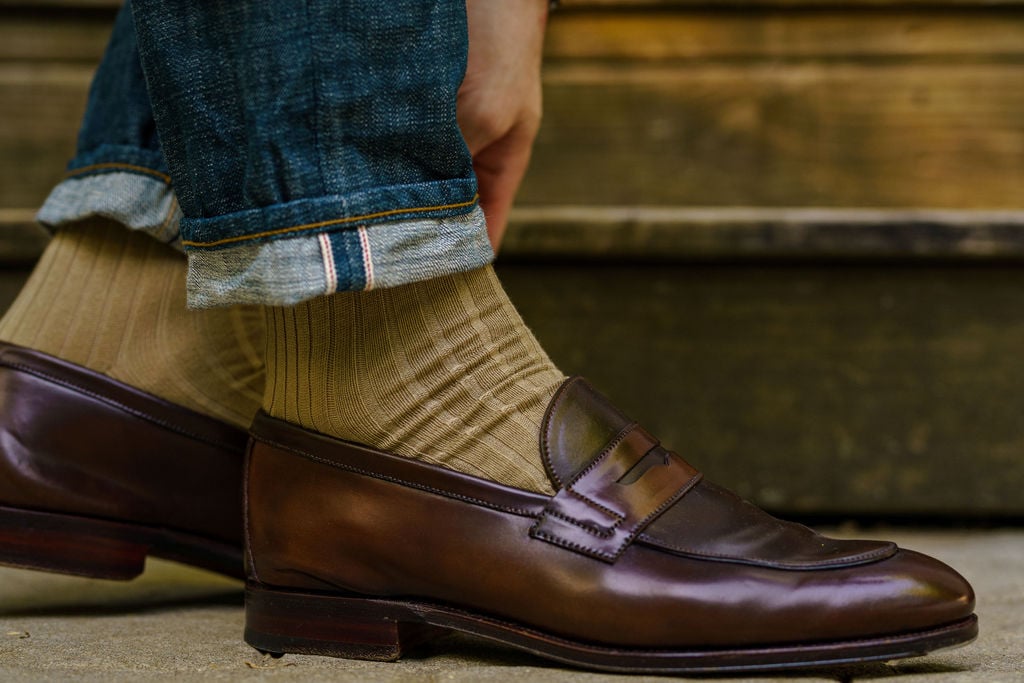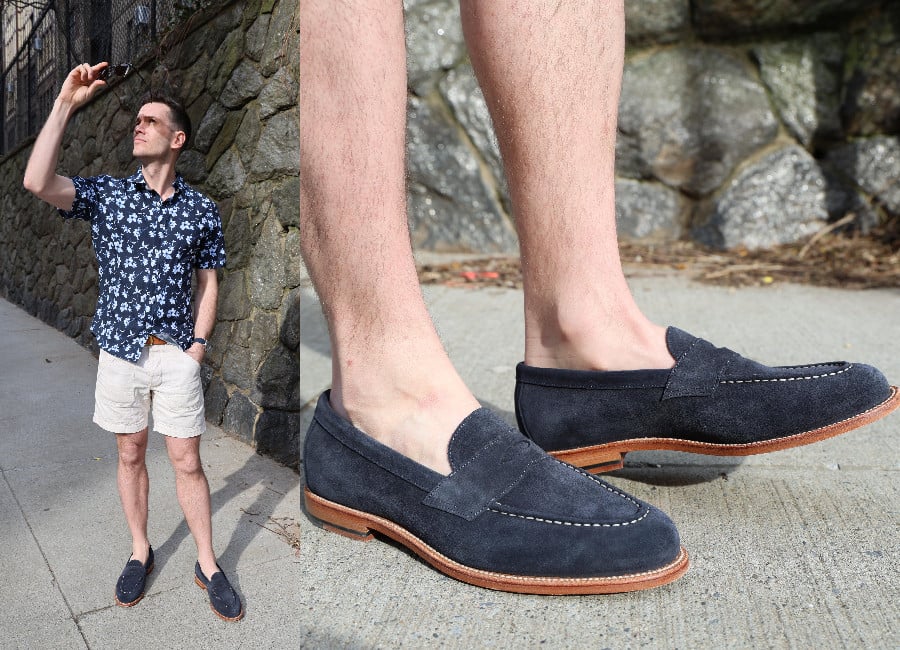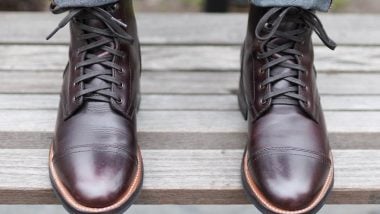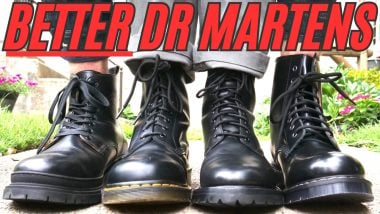How Should Loafers Fit? The Ultimate Guide to Sizing Men’s Loafers

Expert Verified By: Justin FitzPatrick, Shoemaker
Not all shoe styles are created equal, especially when it comes to sizing. Finding the perfect size in a low-top sneaker is not going to be the same process as securing the right fit for cowboy boots. And the same is true of notoriously hard-to-fit loafers.
Dress them up, dress them down — they can be worn with jeans, shorts, chinos, or a suit to work or on vacation. Loafers are super versatile and should be very comfortable.
Just make sure you know how to get a proper fit.
Key Takeaways:
- Loafers should fit snugly, without pain.
- Most guys need to size down a half or full size.
- Loafers stretch over time but not in length.
- Your heel should not slide completely out while walking.
- Use insoles or thicker socks or insoles to tighten loose loafers.
Our Loafer Sizing Experts
Stridewise founder Nick English spoke to Justin FitzPatrick, founder of J. FitzPatrick Footwear in Soho, NYC, for this complete guide about how to size new loafers.
For context: Justin went from retail sales at Nordstrom to learning how to make shoes in Florence, Italy, from a master shoemaker. After learning about cordwaining and cutting his teeth in London and Paris, Justin started J. FitzPatrick, a cool New York brand that emphasizes classic footwear with a twist.
And while his shoes span from boots to oxfords, he sells more loafers than anything else.
Further Reading

10 Best Loafers For Men | Dressy, Chunky & More
We’ve spoken with experts and tested dozens of loafers before landing our 10 favorite pairs.
Learn more →

How Much Room Should You Have in Loafers?
- Loafers should fit snugly, but without pain
- Most guys have to size down a half or full size to get a proper fit
- Leather shoes stretch; loafers may feel a bit too tight when you buy them
- Unlined loafers stretch more than lined loafers
- If you’re wearing them with socks, make sure to size your loafers while wearing them
- Your heel shouldn’t slip out when walking, but you should be able to pop out your heel when flexing your foot’s arch
If you prioritize out-of-the-box comfort with loafers from day one, they’ll likely end up too big. Not only does their laceless design mean they need to fit more snugly than sneakers, but leather shoes also stretch.
“For men, it’s often our first foray into laceless shoes (and) if you come from the mentality of a sneaker wearer — they have allowances because they’re mesh or they’re synthetic or whatever. If you try to emulate a sneaker’s fit on loafers, your foot’s going to come right out.”

Measure Your Feet
So it’s best to walk into a shoe store and get sized on a Brannock device, one of those metal devices with sliders that measure the length, width, and arch of your foot.
You certainly know that your shoe size varies across brands, but instead of getting themselves signed on the “official” measuring device for American feet, most guys simply remember the biggest shoe size they’ve ever fit into, and then they’ll spend the rest of their lives saying that’s their real size.
(Guys like feeling huge. You get it.)
You can buy one on Amazon but we recommend just popping into the next shoe shop you pass and pretend you want to buy shoes.
When you know your Brannock (or “true size”) you’ll have a good starting point: a number to bring to the brand you’re considering buying loafers from. They’ll make recommendations based on that number.
“How shoes fit is very subjective at the same time,” FitzPatrick cautions. “A Brannock could tell you that you measure at size 12, but if your foot is super narrow and shallow, you can’t wear 12 [in leather loafers]. You’d size down to a 10.5 to get a snug fit that doesn’t fall off your feet.”

So, Should You Size Down in Loafers?
- Your loafer size is likely 0.5 down from your “true” Brannock size
- Your loafer size maybe 1 full size smaller than your sneaker size
From your Brannock size? Almost certainly. We’ve worn loafers that are 1.5 sizes smaller than our Brannock, but for you, a good starting point is 0.5 down from your true size.
That’s probably a whole size down from your sneakers, which tend to be worn with plenty of room for dynamic movement — plus, they have laces, so a precise fit isn’t quite as important as it is with loafers.
“Some guys wear their sneakers quite tight, so it depends,” adds FitzPatrick. “But chances are you’ll be a smaller size than your sneakers, especially when transitioning from athletic socks to dress socks and, potentially, no socks.”
Available in over a dozen leathers, this loafer is ubiquitous because of its versatility, tight QC, ease of sizing, and uncommonly durable Goodyear welt construction.
Further Reading

7 Types of Loafers for Men (Horsebit vs Tassel vs Beefroll vs Handsewn)
Want to find the perfect loafer that fits your feet and your style? Learn more →
Remember: Loafers Stretch Over Time
Because they’re made of leather and because they should start off snug, your loafers will stretch a little with wear.
“A loafer at its first stage should feel like a snug glove,” FitzPatrick says. “It needs to basically hug your foot, and you should feel the leather around all of your foot grabbing you, especially in Goodyear welted shoes.”
(That’s a common way of making resoleable shoes. The Blake stitch is another one you often see in loafers.)

FitzPatrick encourages buyers to think long-term when feeling out the fit: how does the shoe accommodate the width, and how much room is in the toe box? Because one important fact is that loafers will stretch in the width and the instep (the top of the foot), but not in the length.
After break-in, once the leather softens, you’re going to gain millimeters of volume. Those millimeters of volume make a huge difference and will finally allow you to achieve that comfortable and perfect fit.
Justin FitzPatrick

Sizing Loafers: Socks vs No Socks
Guys often wear loafers with thin socks or no socks. This is another element that differentiate how we size loafers versus sneakers, which are often worn with athletic socks.
Decide if you’re wearing loafers with socks or not, and try the loafers on that way. Some folks wind up buying an even smaller size if they’re planning to go sockless, especially if it’s an unlined loafer, which will stretch more.
Fully leather lined, full grain box calf leather uppers, and hand-lasted waists, this is one classy loafer.

The difference between “snug” and “too tight“
Leather shoes are the least comfortable the first day you get them, which is another lesson that’s important to learn if you’re more used to sneakers. Loafers should feel more comfortable every time you wear them because the leather and footbed slowly conform to your foot’s shape.
But do not get shoes that are painful when you first wear them.
“Comfort” can be pretty subjective: FitzPatrick explains that in France, loafers are worn so tight that “there are no molecules of space inside, and they find that comfortable.” Americans wouldn’t.
“(But) if it’s painfully uncomfortable to take a step, that’s probably not good,” he concludes. “If it’s just snug to the point where you’re noticing that shoe hug your foot? Maybe you’re not used to that sensation, but you’re pressing against the sides, but not in a painfully uncomfortable way? That should be okay, because that’s going to give.”

How much heel slip is OK in loafers?
It’s OK if your shoes feel snug, and your heel should not slide out while walking. But you should still be able to take your loafers off easily.
There’s a huge misconception where if a guy can forcefully pull his ankle out of his loafer he’ll think it’s too big. No. You can do that even in the perfect size.
Justin FitzPatrick
If you sit down, cross a leg over your knee, and flex your arch and push the ball of your foot down, your heel will probably pop out. That’s fine, because your foot doesn’t move that way when you’re walking.

Ways to Make Loafers Fit
Are your loafers a bit loose, or do you not have enough room in the toe box? There are a few things you can try to get a better fit.
How to make loafers bigger
Can you stretch loafers that are too tight? Yes and no.
You can stretch the sides (the width) and the instep height, but you can’t stretch the length.
“You can either take it to a cobbler who has [special tools], or you can buy the shoe stretchers on Amazon as I did,” says FitzPatrick, who often has to stretch part of his shoes to accommodate an old soccer injury. Shoe stretchers use adjustable screws to slowly but effectively make different parts of your shoe bigger until you reach the perfect size.

There are some “home remedies” that people use to stretch their shoes, like freezing them with a bag of water inside, but FitzPatrick doesn’t recommend most of them.
“I’ve never done the water and the freezing and the bag and all of that stuff,” he says, noting that some guys submerge their loafers in water and walk around in them as they dry in order to speed up the break in. “A lot of these ‘remedies’ risk damaging the shoe and can cause leather breakdown, mold, and other problems you don’t want to deal with.”
He does allow for one other home remedy: jamming a broom handle into the shoe and against the spot where you need more room.
But ultimately, if your loafers are too tight when you walk around, we recommend sticking with a shoe stretcher or consulting a cobbler to make sure you don’t end up with an unwearable shoe.
Can you make loafers smaller?
You can’t really make a loafer smaller.
But you’d be surprised how much difference an extra insole can make. Many brands include one with your shoebox or they sell them as add-ons. An insole fills up extra space in the loafer, and some guys cut the insole in half to just fill one part of it. (Add a little glue underneath if the insole keeps coming out.)
Other options are wearing thicker socks, slipping a tongue pad on top of the shoe, or using heel or toe fillers to take up space on one (or both) ends of the shoe.
Still, there’s a good chance you won’t be able to do anything to fix an ill-fitting loafer. This is another reason why starting with the correct size is so important.
The Benefits of Shoe Trees for Loafers
Some loafer enthusiasts like to invest in shoe trees to maintain the shape of the loafer. While your loafers won’t disintegrate without them, they do have real benefits.
Made in the US from sustainably grown red cedar trees, these shoe trees for loafers maintain your shoes' form and absorb moisture to keep them looking and smelling great.
Shoe trees make a shoe last longer by helping to dry out the moisture that accrues during the day. They also reduce leather creasing and help the shoe to maintain its shape, something that’s extra important for the laceless loafer.
Opting for cedar over plastic is worth it, since the cedar is better at managing moisture and preventing odor — especially helpful if you wear your loafers without socks.

Enjoy the Perfect Fit for Your New Pair of Loafers!
If you’ve followed our tips above, you should be well on your way to owning a perfect-fitting pair of classic loafers. If you’re ever in New York City, check out J. FitzPatrick Footwear for some seriously expert shoe knowledge; many thanks to Justin for his advice on this common footwear query.
FAQs
Getting a proper fit for flat feet is challenging, especially with laceless shoes like loafers. A lot guys with flat feet may need a lower volume shoe and benefit from a shoe with laces. For laceless loafers, it’s best to size down, making sure they feel comfortable with no pain.
Allen Edmonds loafers, or AE shoes, are American-made with European calfskin and we’ve found the fit to be superb, largely because they’re available in 4 widths. They’re also resoleable and have shock absorbing insoles for comfort.












